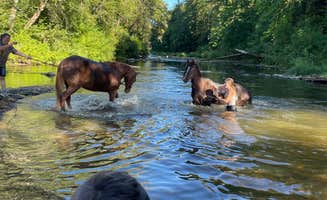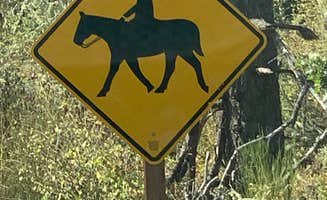L.L. Stub Stewart Memorial State Park sits at approximately 1,800 feet elevation in Oregon's Coast Range, providing varied terrain for equestrian exploration through mixed conifer forests. The park spans 1,800 acres with trail elevation changes creating challenging routes for riders. During summer months, temperatures typically range 65-85°F, while winter brings cooler 35-50°F conditions with frequent rainfall.
What to do
Trail exploration: The Banks-Vernonia State Trail connects with multiple equestrian-friendly paths, creating extensive riding options. At Dairy Creek East — L.L. Stub Stewart Memorial State Park, riders access a multitude of recreational opportunities. According to a camper, "The park's well-maintained full hookup sites with 50amp, most 63' long. The park has recently renewed trail signage" which helps equestrians navigate the extensive system.
Horse-friendly recreation: Mountain biking paths intermingle with equestrian trails throughout the region. One visitor noted, "Open feel, but sites are spacious. Nice playground for kids, fun disc golf course and wonderful access to biking (paved or dirt)," making this area suitable for multi-activity families with horses.
Winter equestrian camping: Most facilities remain accessible year-round with reduced crowds. A camper at Hares Canyon Horse Camp — L.L. Stub Stewart Memorial State Park shared, "The top of the park shows a vast section of sky which is perfect for meteor shower watching," highlighting the clear winter night skies equestrians can enjoy during off-season visits.
What campers like
Practical horse facilities: Dedicated corrals provide secure containment while camping. A reviewer described the specific accommodations: "The Campground is set up in one loop and offers both single and double sites, ADA facilities, showers, toilets, and trash. Each site has a picnic table, fire pit, and a corral. There is a double corral on the double sites."
Direct trail access: Multiple trailheads connect directly from campsites. At Jones Creek, a camper reported, "We love staying in the campground! There are many river access points, the forestry center, walking trails and wildlife all within walking distance. The campsites are on a first come first serve basis and many of them are pretty big."
Versatile camping options: Different accommodations suit varied equestrian needs. The region offers diversity, as one visitor to Tillamook State Forest Stagecoach Horse Camp noted: "This area is a really nice area to explore with some elevation gain. There are some existing campfire rings along the road. Boondocking is allowed."
What you should know
Seasonal usage variations: Busier summers require advance planning for equestrian sites. A reviewer at Dairy Creek West — L.L. Stub Stewart Memorial State Park shared that "Aside from the sites, the park has many hiking trails of varying length, access to the Banks-Vernonia State Trail, several disc golf courses, cabins, a horse camp, a day use picnic/event area and a hike-in camp area."
Wildlife awareness: Local wildlife includes predators requiring proper food storage. One camper experienced this firsthand: "When we came back from the shower my wife and I observed a dark shadow darting from the table around the back corner of the tent. Figured it was a raccoon or something. Half an hour later I went behind the tent to get a Pepsi, and there it was, a cat. A bobcat to be exact."
Trail condition monitoring: Rain impacts trail quality significantly. During wetter months, riders should check conditions as one visitor noted during their experience: "My husband and I have stayed here twice and both times it has rained. Which is fine but we find it very humorous (and actually really enjoy camping in the rain)."
Tips for camping with families
Children-friendly activities: Nearby disc golf courses provide alternative recreation. A visitor mentioned: "What makes this CG so special is the multitude of hiking, biking, and horse trails. They even have a disc golf course within the park."
Tent placement strategy: Select sites based on proximity to facilities. A camper at Battle Ground Lake State Park Campground advised: "The campsite we picked was a mix of things: just far enough away from the restrooms where we don't get all the traffic there, but close enough so it's not too far either. We were within easy walking distance to two restrooms/showers."
Mud preparation: Pack appropriate footwear for everyone during wet seasons. One camper warned: "The tent pads are a typical woodsy mix of pine straw, leaves, and loose gravel. Sleeping pads are a blessing, but so are nicely stacked lead piles in a pinch."
Tips from RVers
Site selection: Western loops typically offer more privacy for larger rigs. As noted by one RV camper: "The Dairy Creek West loop has more shaded and privacy for most of the sites if thats what you are seeking, while the East loop is more open and affords a more social experience."
Hookup access: Water and electrical connections often require longer hoses/cords. At Nehalem Bay State Park Campground, a visitor shared practical site details: "rv spots are nice and level but not much privacy between spaces. very nice setup with yurts right across the drive from rvs in loop a. nice for meeting family or friends with no vehicle."
Water pressure considerations: Some sites experience lower pressure during peak usage. One RVer specifically mentioned this concern: "Water pressure is the lowest we've ever experienced. Not sure what's going on but all of the folks we've talked to are experiencing the same."





